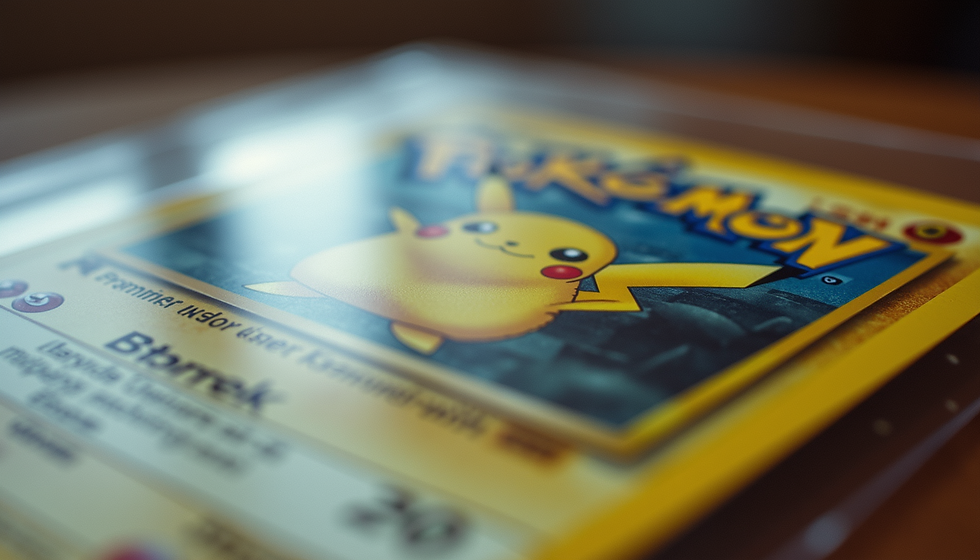PSA Card Grade Scale Explained: A Guide to Grading Systems and Card Value Impact
- Celestrion-TCG

- Jun 1
- 4 min read

Grading has become a cornerstone in the realm of trading card collecting, playing a pivotal role in determining a card's value and collectibility. When you explore the PSA card grade scale explained, you'll discover how the grading intricacies affect the impact of grade on card value. This article will guide you through the grading systems of notable services like PSA (Professional Sports Authenticator) and BGS (Beckett Grading Services), discussing questions like what does BGS 9.5 mean? and highlighting some of the highest graded trading cards ever.
What Is Card Grading & Why It Matters
Card grading is a process where collectors submit their valuable cards to a third-party service for professional evaluation of their condition. This evaluation directly impacts the card’s value and desirability. Among the multitude of grading services, PSA and BGS stand as industry leaders. PSA employs a respected 10-point scale, an industry benchmark renowned for consistency and reliability. Understanding this process is crucial for collectors striving to grasp the impact of grade on card value. For a comprehensive overview of the best trading card grading companies, visit Best Trading Card Grading Companies.
Overview of Different Grading Scales (PSA vs. BGS)
PSA's 1-to-10 Grading Scale
The PSA grading scale extends from 1 (Poor) to 10 (Gem Mint), with each grade representing a specific condition standard. This scale has become the industry benchmark for card quality.
BGS's Sub-Grade System
Unlike PSA’s single overall grade, BGS incorporates sub-grades for centering, corners, edges, and surface. A BGS 9.5, termed "Gem Mint", is often a comparison point to the PSA 10. However, nuanced differences in sub-grades can lead to significant value differences, addressing the curiosity around "what does BGS 9.5 mean?". Understanding these nuances is essential, as detailed in Understanding What BGS 9.5 Means.
Detailed Breakdown of the PSA Card Grade Scale
PSA 1 Through PSA 10: What Each Grade Means
PSA 10 - Gem Mint A near-perfect card with excellent centering, pristine corners, and no surface damage. Centering must fall within approximately 55/45 to 60/40 on the front and 75/25 on the back. These are free of any staining.
PSA 9 - Mint Minimal imperfections, such as slight off-centering or a printing issue.
PSA 8 - Near Mint-Mint Minor corner fraying or minor printing faults, with centering slightly off.
PSA 7 - Near Mint Slight surface wear or minor printing blemishes, slightly off-centered.
PSA 6 - Excellent-Near Mint Visible surface wear or defects; corners may display more rounding.
PSA 5 - Excellent Corners show rounding, more visible surface or printing defects.
PSA 4 - Very Good-Excellent Noticeable wear, light scratches, and off-center alignment.
PSA 3 - Very Good Significant wear with potential light creasing.
PSA 2 - Good Substantial wear with possible major creasing or corner issues.
PSA 1 - Poor Significant damage or alteration with heavily worn edges and corners.
Centering as a Critical Element
Centering forms a pivotal aspect in grading, where PSA measures the proportional borders. This consistency ensures reliable card assessments.
What Does BGS 9.5 Mean?
BGS uses an overall scale from 1 to 10 while marking sub-grades. A BGS 9.5 is deemed "Gem Mint" in Beckett’s terms, fundamentally comparable to a PSA 10, but the sub-grades for centering, corners, edges, and surface might yield value differences. While some collectors may favor a BGS 9.5 over a PSA 10 depending on sub-grades, understanding "what does BGS 9.5 mean?" can help in better decision-making. For insights on how to authenticate rare Pokémon cards, refer to How to Authenticate Rare Pokémon Cards.
Impact of Grade on Card Value
Significance of PSA Grading
A PSA grade greatly influences card market values. The difference between PSA 9 and 10 often translates to thousands of dollars, especially for in-demand cards (source). Understanding these nuances is crucial for investors deciding whether to submit cards for grading based on the impact of grade on card value. To maximize returns, explore Best Trading Card Games to Invest In.
Notable Sales Examples
The market has seen instances where a half-point or single grade discrepancy caused substantial auction price variations. Such differences emphasize how grading decisively alters trading card value, resonating the highest graded trading cards ever scenario.
Highest Graded Trading Cards Ever
Famous Cards and Market Impact
Examples of cards receiving PSA 10 or BGS 9.5 or higher command astronomical prices, with iconic cases like rare baseball or Pokémon cards breaking records. These grades elevate collectible statuses and influence market values, tying into the essence of the highest graded trading cards ever.
Grading's Influence on Market
The card's grade can turn it into a sought-after collectible, often impacting sales and market dynamics significantly, thus reiterating the PSA card grade scale explained concept.
Conclusion
Grasping the significance of the PSA card grade scale explained helps collectors navigate the trading landscape, understanding the impact of grade on card value. Awareness of nuances like what does BGS 9.5 mean? aids in learning how different grading services weigh cards. Whether you’re buying or selling, applying this grading knowledge is beneficial.
Call to Action
For further insights, explore related topics such as handling graded cards safely, selecting the right grading service between PSA and BGS, and preparing cards to achieve the highest graded trading cards ever. Subscribe for more insights into the world of card collecting and grading.




Comments